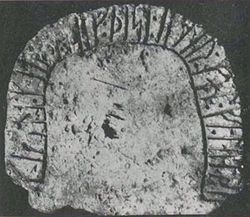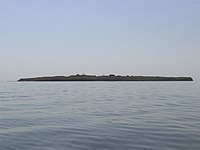140:, while others had received wooden coffins or had at least been put on planks before the inhumation, while some had been inserted into stone coffins made of flat slabs of stone. On June 9, 1905, von Stern's crew discovered a lidless stone coffin in the eastern part of the kurgan containing a skeleton whose skull was resting on the runestone. The runestone was discovered by von Stern just as a worker intended to throw it on a pile of stone. The runestone was probably not discovered in its original location, and it is likely that it was originally located at one of the minor barrows in the vicinity.
20:
88:
117:) and the difficulties of sandbanks and treacherous shoal-water still fresh in his memory, he came at last, here by Berezanj, to open water, where the Black Sea, bigger than the Baltic, opened up before his ship's prow. And when he came to Berezanj from the south - on his way to the thick-wooded creeks of
121:
or the stony havens of
Gotland - he could gather strength here before being forced to bend back and oar in the long struggle against the river currents and all the other obstacles in his way. Soon enough the time would come for the unloading and the dragging over the portages and the reloading, all
343:
Few runic inscriptions have been discovered in
Eastern Europe because stone material was scarce. It may also have been due to the tradition of inscribing runes on wooden poles that were erected on the barrows, something which was described by
135:
from the 6th century BC. After its construction, the kurgan had been used for 48 additional burials of different types and at various depths. None of the bodies appeared to have been incinerated; some had been carelessly buried without any
429:(1886-1910) director of the Imperial Museum at Odessa (1895-1910), professor of Ancient History and Archaeology at the University of Halle, (1911- ), Rector (1921- ). (Alfons Paquet, Wilhelm Groener, Albert Hopman,
148:
The inscription is completely preserved, which is shown by the fact that the first and last letters are marked as the end parts of the inscription. The engravings are c. 8 cm long and 0.75 cm deep.
335:
of Grani indicates that they were operating in a mercantile partnership, but it has been suggested that it could have referred to them as members of the same retinue.
322:
but that Karl died and so Grani prepared his last resting place on an island that had always been visited by sailors, and which the
Byzantines called the "island of
101:
Berezan' is located in the Black Sea not far from the mouth of the
Dnieper River. Its bays gave shelter to the Scandinavian ships that passed it on the
620:
669:
397:
102:
311:(both being regions in present-day Sweden). There are no special traits in the inscription that suggests that it was written in the
151:
607:
55:
is 48 cm (19 in) wide, 47 cm (19 in) high and 12 cm (4.7 in) thick, and kept in the museum of
542:
Braun, F. & Arne, T. J. (1914). "Den svenska runstenen från ön
Berezanj utanför Dneprmynningen", in Ekhoff, E. (ed.)
392:
577:
562:
592:
Cambridge, Mass.: Distributed by
Harvard University Press for the Harvard Ukrainian Research Institute.
299:
It is difficult to determine from where Grani and Karl came. In runic inscriptions, the Old Norse word
315:
dialect of Old Norse, but the shape of the runestone and its placement are usually found on
Gotland.
113:
When the traveller came from the north, with the perils of the Dniepr cataracts (mentioned on the
323:
114:
280:
krani : kerþi : (h)alf : þisi : iftir : kal : fi:laka : si(n)
553:
122:
in the sticky heat of the interior, hardly relieved by the steppe winds and the summer rain.
426:
402:
8:
664:
659:
368:
had been assimilated by the Slavic majority, and the influx of new settlers had ceased.
308:
547:
603:
573:
558:
377:
353:
352:. By the time the raising of runestones became fashionable in the 11th century, most
106:
595:
382:
585:
36:
319:
318:
It is likely that the
Gotlanders Grani and Karl were on their way to, or from,
96:
40:
653:
635:
622:
44:
387:
312:
137:
431:
345:
554:
Viking Rus: Studies on the
Presence of Scandinavians in Eastern Europe
118:
60:
52:
48:
19:
331:
284:
258:
68:
612:
492:
422:
365:
361:
304:
109:, later Sweden's National Antiquarian, writes on its importance:
72:
32:
357:
132:
76:
64:
349:
56:
87:
131:
The runestone was discovered during the excavations of a
290:"Grani made this vault in memory of Karl, his partner."
421:
Ernst Wallfried (E.R.) von Stern (1859-1924), born in
283:
Grani {} gærði {} hvalf {} þessi {} æftiʀ {} Karl, {}
43:(also known as the Island of St Aitherios) where the
651:
398:Trade route from the Varangians to the Greeks
103:trade route from the Varangians to the Greeks
478:
476:
474:
348:who met Scandinavians on the shores of the
329:The runestone's description of Karl as the
523:
507:
505:
503:
501:
462:
455:
453:
451:
441:
439:
471:
86:
18:
16:Runestone discovered in Berezan, Ukraine
567:
652:
498:
448:
436:
67:) trader named Grani in memory of his
670:Byzantine Empire-related inscriptions
307:, and in some late inscriptions from
303:("vault", "coffin") only appears in
13:
393:Runic inscriptions in Hagia Sophia
14:
681:
152:Transliteration and transcription
600:Särkland och dess källmaterial
514:
485:
415:
143:
71:Karl. They were probably from
1:
536:
338:
126:
35:) was discovered in 1905 by
7:
371:
294:
82:
10:
686:
94:
39:, professor at Odessa, on
602:. Göteborgs universitet.
568:Jansson, S. B.F. (1997),
511:Braun & Arne 1914:48
459:Braun & Arne 1914:45
445:Braun & Arne 1914:44
408:
491:Entry X UaFv1914;47 in
425:, was professor at the
23:The Berezanj Runestone.
427:Novorossiya University
124:
92:
24:
636:46.60000°N 31.41000°E
354:Scandinavian settlers
111:
90:
22:
403:Varangian runestones
632: /
590:The origin of Rus'.
551:Duczko, W. (2004).
544:Fornvännen årgång 9
468:Thunberg 2011:54-55
59:. It was made by a
641:46.60000; 31.41000
93:
29:Berezan' Runestone
25:
608:978-91-637-5727-3
596:Thunberg, Carl L.
433:, 1971:614, note.
378:Greece Runestones
107:Sven B.F. Jansson
677:
647:
646:
644:
643:
642:
637:
633:
630:
629:
628:
625:
582:
530:
529:Pritsak 1987:306
527:
521:
518:
512:
509:
496:
489:
483:
480:
469:
466:
460:
457:
446:
443:
434:
419:
383:Italy Runestones
69:business partner
685:
684:
680:
679:
678:
676:
675:
674:
650:
649:
640:
638:
634:
631:
626:
623:
621:
619:
618:
580:
570:Runes in Sweden
539:
534:
533:
528:
524:
520:Duczko 2004:252
519:
515:
510:
499:
490:
486:
482:Jansson 1997:61
481:
472:
467:
463:
458:
449:
444:
437:
420:
416:
411:
374:
341:
297:
292:
278:
270:
262:
252:
244:
236:
228:
220:
212:
204:
196:
188:
180:
172:
164:
146:
129:
99:
85:
41:Berezan' Island
37:Ernst von Stern
17:
12:
11:
5:
683:
673:
672:
667:
662:
616:
615:
610:
593:
583:
578:
565:
549:
538:
535:
532:
531:
522:
513:
497:
484:
470:
461:
447:
435:
413:
412:
410:
407:
406:
405:
400:
395:
390:
385:
380:
373:
370:
340:
337:
324:Saint Etherius
320:Constantinople
296:
293:
271:
263:
253:
245:
237:
229:
221:
213:
205:
197:
189:
181:
173:
165:
157:
156:
145:
142:
128:
125:
97:Berezan Island
95:Main article:
84:
81:
15:
9:
6:
4:
3:
2:
682:
671:
668:
666:
663:
661:
658:
657:
655:
648:
645:
614:
611:
609:
605:
601:
597:
594:
591:
587:
584:
581:
579:91-7844-067-X
575:
571:
566:
564:
563:90-04-13874-9
560:
556:
555:
550:
548:
545:
541:
540:
526:
517:
508:
506:
504:
502:
494:
488:
479:
477:
475:
465:
456:
454:
452:
442:
440:
432:
428:
424:
418:
414:
404:
401:
399:
396:
394:
391:
389:
386:
384:
381:
379:
376:
375:
369:
367:
363:
359:
355:
351:
347:
336:
334:
333:
327:
325:
321:
316:
314:
310:
309:Västergötland
306:
302:
291:
288:
286:
281:
277:
274:
269:
266:
261:
260:
256:
251:
248:
243:
240:
235:
232:
227:
224:
219:
216:
211:
208:
203:
200:
195:
192:
187:
184:
179:
176:
171:
168:
163:
160:
155:
153:
149:
141:
139:
134:
123:
120:
116:
115:Pilgård stone
110:
108:
104:
98:
89:
80:
78:
74:
70:
66:
62:
58:
54:
50:
46:
45:Dnieper River
42:
38:
34:
33:X UaFv1914;47
30:
21:
617:
599:
589:
569:
552:
543:
525:
516:
487:
464:
430:
417:
388:Piraeus Lion
342:
330:
328:
317:
300:
298:
289:
282:
279:
275:
272:
267:
264:
257:
254:
249:
246:
241:
238:
233:
230:
225:
222:
217:
214:
209:
206:
201:
198:
193:
190:
185:
182:
177:
174:
169:
166:
161:
158:
150:
147:
130:
112:
100:
28:
26:
639: /
586:Pritsak, O.
546:pp. 44-48.
313:Old Gutnish
144:Inscription
138:grave goods
91:The island.
665:Varangians
660:Runestones
654:Categories
627:31°24′36″E
624:46°36′00″N
537:References
346:Ibn Fadlan
339:Uniqueness
47:meets the
557:. BRILL.
127:Discovery
61:Varangian
53:runestone
49:Black Sea
598:(2011).
588:(1987).
372:See also
295:Identity
287:{} sinn.
83:Location
613:Rundata
493:Rundata
423:Livonia
366:Ukraine
362:Belarus
305:Gotland
255:fi:laka
119:Mälaren
73:Gotland
606:
576:
561:
358:Russia
285:felaga
268:
259:felaga
250:
234:
218:
202:
191:(h)alf
186:
170:
133:kurgan
77:Sweden
65:Viking
51:. The
409:Notes
350:Volga
332:félag
301:hvalf
276:sinn.
273:si(n)
242:Karl,
226:æftiʀ
223:iftir
210:þessi
194:hvalf
178:gærði
175:kerþi
162:Grani
159:krani
57:Odesa
604:ISBN
574:ISBN
559:ISBN
364:and
326:."
207:þisi
27:The
495:2.0
356:in
239:kal
656::
572:,
500:^
473:^
450:^
438:^
360:,
154::
105:.
79:.
75:,
265::
247::
231::
215::
199::
183::
167::
63:(
31:(
Text is available under the Creative Commons Attribution-ShareAlike License. Additional terms may apply.

